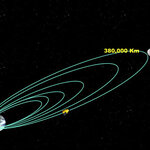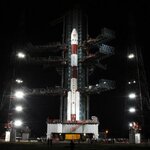Aerospace

I had this video forwarded to me, and have to say that initially I was stunned.
"Man! This pilot is one lucky guy!"
But then I immediately began to wonder, why didn't I see this on the news - like a billion times? I mean, if a camera happens to capture a horse running loose on the highway, all the major networks seem to carry it on the 5:00 news. But this? I hadn't seen it on a single channel.
So after a second look (and third), I have to admit my "awe" turned more into "Ahhhh... I think they're trying to pull a fast one on us." And I'm clearly not the…

Record-breaking accomplishments confuse people about durability. In facing the frailty of humans and their machines, a 'sea of safety' is a comforting notion. Failures remind us safety can be improved. Take the Phoenix Mars Lander, our machine to touch water on another planet. Its operations came to an end on recent days in the arctic plains when sunlight became insufficient. The machine simply stopped working outside its operating parameters.
There are limits to our presence on Earth and in space. Twenty people suffocated in…

Chandrayaan-1, the Indian Space Research Organisation’s (ISRO) lunar orbiter, was captured into orbit around the Moon on 8 November. One day later, the spacecraft performed a manoeuvre that lowered the closest point of its orbit down to 200 km from the Moon. The spacecraft’s liquid-fuel propelled engine was fired at 12:21 CET (16:51 Indian Standard Time) when it was at a distance of about 500 km from the Moon. This reduced the spacecraft’s velocity, enabling the Moon’s gravitational field to capture Chandrayaan-1 into lunar orbit. In this configuration, the orbit’s point closest to the…

Yesterday, following a fifth orbit-raising maneuver, the Chandrayaan-1 spacecraft successfully settled into a trajectory that will take it to the Moon. After launch on 22 October, the spacecraft was first injected into an elliptical 7-hr orbit around Earth, between 255 km and 22 860 km above our planet. After five engine firings, Chandrayaan-1 spiralled outwards in increasingly elongated ellipses around Earth, until it reached its lunar transfer orbit on 4 November at 00:26 CET (04:56 Indian standard time).
In the fifth and last orbit-raising maneuver, the spacecraft’s 440 Newton…

Armadillo Aerospace of Rockwall, Texas, earned $350,000 in NASA prize money during the Northrop Grumman Lunar Lander Challenge in Las Cruces, N.M.
The challenge is a two-level, $2 million competition designed to accelerate commercial space technology and is sponsored by NASA's Centennial Challenges program. After Armadillo's $350,000 first place win for level one this year, $1.65 million remains as available prize money for future competitions.
Armadillo's winning vehicle successfully demonstrated some of the technologies needed for a lunar lander capable of ferrying payloads or…

Yesterday, the Zefiro 9-A motor successfully completed its first firing test at the Salto di Quirra Inter-force Test Range in Sardinia (Italy). This was the penultimate firing test for the engine prior to the Vega launcher’s qualification flight, scheduled to take place by the end of 2009. The Zefiro 9-A (Z9-A) solid-fuel rocket motor, which will power the Vega launch vehicle’s third stage, left the production facility of Avio, in Colleferro (Italy), at the end of September and was installed at the test site over the last three weeks. After a nominal 120-second burn time,…

Chandrayaan-1, India’s first mission to the Moon, was successfully launched earlier this morning from the Satish Dhawan Space Centre (SHAR) in Sriharikota, India.
The PSLV-C11 rocket, an upgraded version of the Indian Space Research Organization’s (ISRO’s) Polar Satellite Launch Vehicle, lifted off at 02:52 Central European Summer Time (CEST) and injected the spacecraft into a highly elongated orbit around the Earth.
Chandrayaan-1 is led by ISRO and the international partners include ESA, Bulgaria and the USA.
The Chandrayaan-1 launcher, ISRO's PSLV-C11, is an upgraded version of the…

As the global demand for air travel increases, so too does the demand to decrease the environmental impact of flight. The answer may lie in the technological advances made by the next generation of short-haul commercial aircraft currently in development by British low-cost airline, EasyJet. The unique design of EasyJet’s “EcoJet” promises a 50% reduction in CO2 emissions by 2015.
The aircraft will incorporate the latest research by airframe and engine manufacturers around the world – all of which can be incorporated into an aircraft that should be in operation by 2015. The projection for the…

Zhai Zhigang, a Chinese taikonaut, exited his spacecraft Shenzhou 7 for a spacewalk at about 0840 GMT on 27 September 2008. He completed his 18 minutes in space after retrieving a solid lubricant sample on the outside of the spacecraft.(1)
Zhai's spacesuit was reportedly a Chinese-built "Feitian" (or "fly the sky" in Chinese) weighing about 265 pounds (120 kg).(2) Probably, a modified Russian-suit, i.e. Orlan, Feitian took 15 hours to assemble and to don. An Orlan would have taken 4 to 6 hours to be spacewalk-ready in comparison.
Although no manned maneuvering unit (MMU) of the USA, Feitan…

Wile E. Coyote has nothing on this guy.
Yves Rossy, aka Jet Man, zoomed into the record books this morning, flying across the English Channel strapped to a single jet-powered wing, with only a helmet and flight suit for protection.
The 22-mile (35-kilometer) France-to-England journey took 13 minutes. Bad weather had twice postponed the event this week. But this morning—with clear blue skies and a nice tailwind—turned out to be an ideal flight day for the Swiss airline pilot.
Around 2 p.m., local time, Rossy leaped from a plane abound 8,200 feet (2,500 meters) above a beach near Calais.…